#tarotqabalahthothmagickelitarotstrickingly.com
Above all things, know thyself!

Thoth-10 of Cups- Satiety
#10. The Kingdom of Spirit is embodied in my flesh.
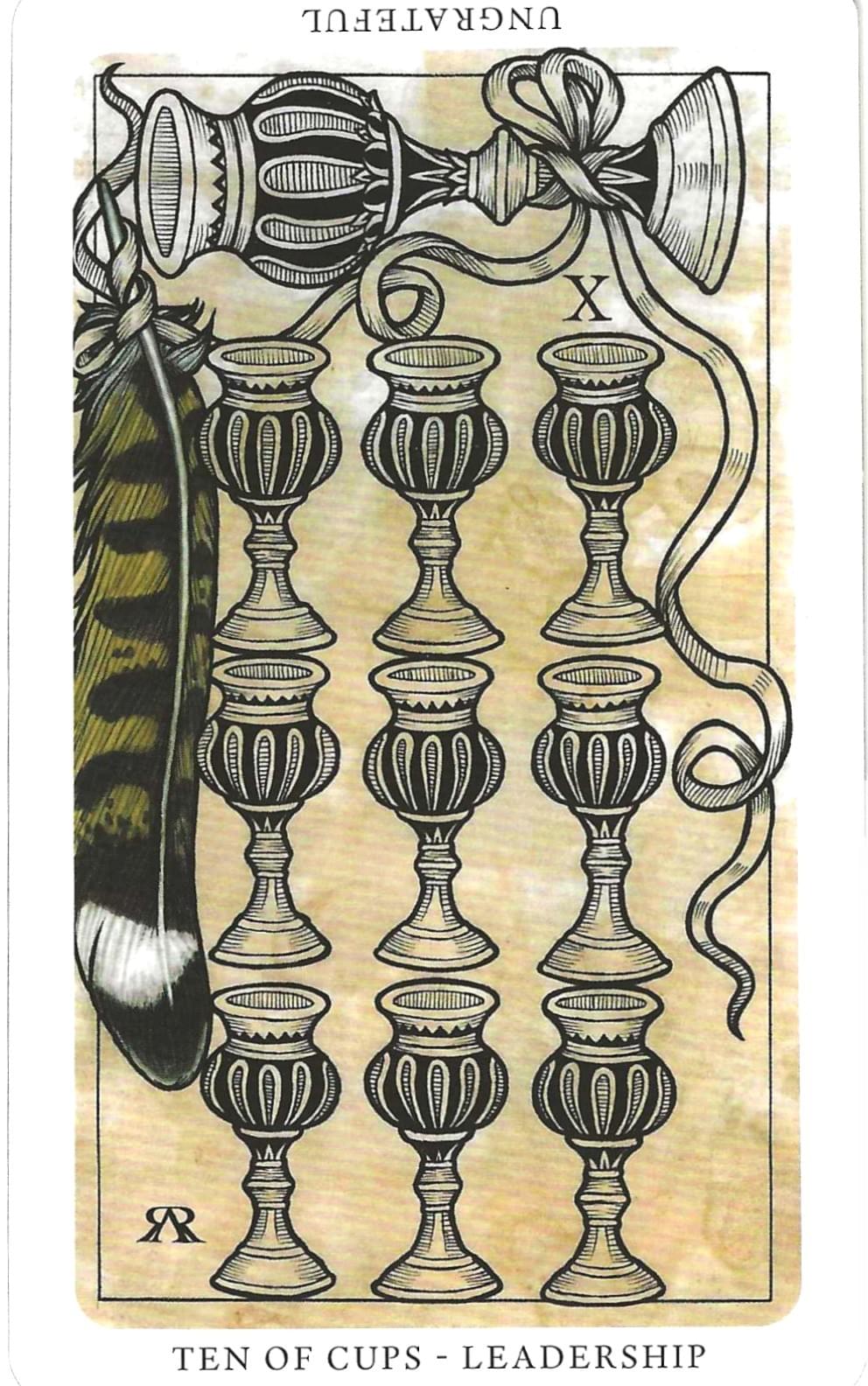
Medieval Feathers Tarot- 10 of Cups


The Thoth 10 of Cups – Satiety (Mars in Pisces, Malkuth in Briah)
MALKUTH, the manifest Kingdom, is the 10th Sephirah on the Tree of Life. It is the Earth, the Microcosm, the field of actualization where all higher forces take form. In Tarot, Malkuth governs the four 10s, each one showing the final crystallization of an elemental suit. The Thoth 10 of Cups is called Satiety, and astrologically attributed to Mars in Pisces. Crowley names this card The Lord of Perfected Success, for it depicts the influence of Malkuth within Briah, the Qabalistic World of Creation.
Satiety – Fullness and Its Limits
The word satiety means to be filled to excess. At first glance, “excessive happiness” may not sound problematic—but the esoteric warning here is subtle. In Qabalah, perfection marks the end of transformation, for when a cycle has reached its peak, it must close. No further change is permitted when one rests in perfection. To remain in this state indefinitely would result in stagnation, the “madness of paradise without movement.” Hence, the 10 of Cups teaches that when happiness has been perfected, the cycle must shift—one must descend, empty the cup, and prepare for new waters to flow.
This card is often read as bliss, emotional fulfillment, and harmony on the material plane—yet beneath that, it is also the warning bell that a cycle has reached its zenith. It is time for change, or else fullness collapses into numbness.
Mars in Pisces – A Peculiar Alchemy
Ordinarily, Mars is uncomfortable in Pisces. Pisces is a mutable water sign, diffusive and dreamy, while Mars is fiery, assertive, and aggressive. Normally, Mars in Pisces could scatter energy into frustration, as force disperses into boundless waters.
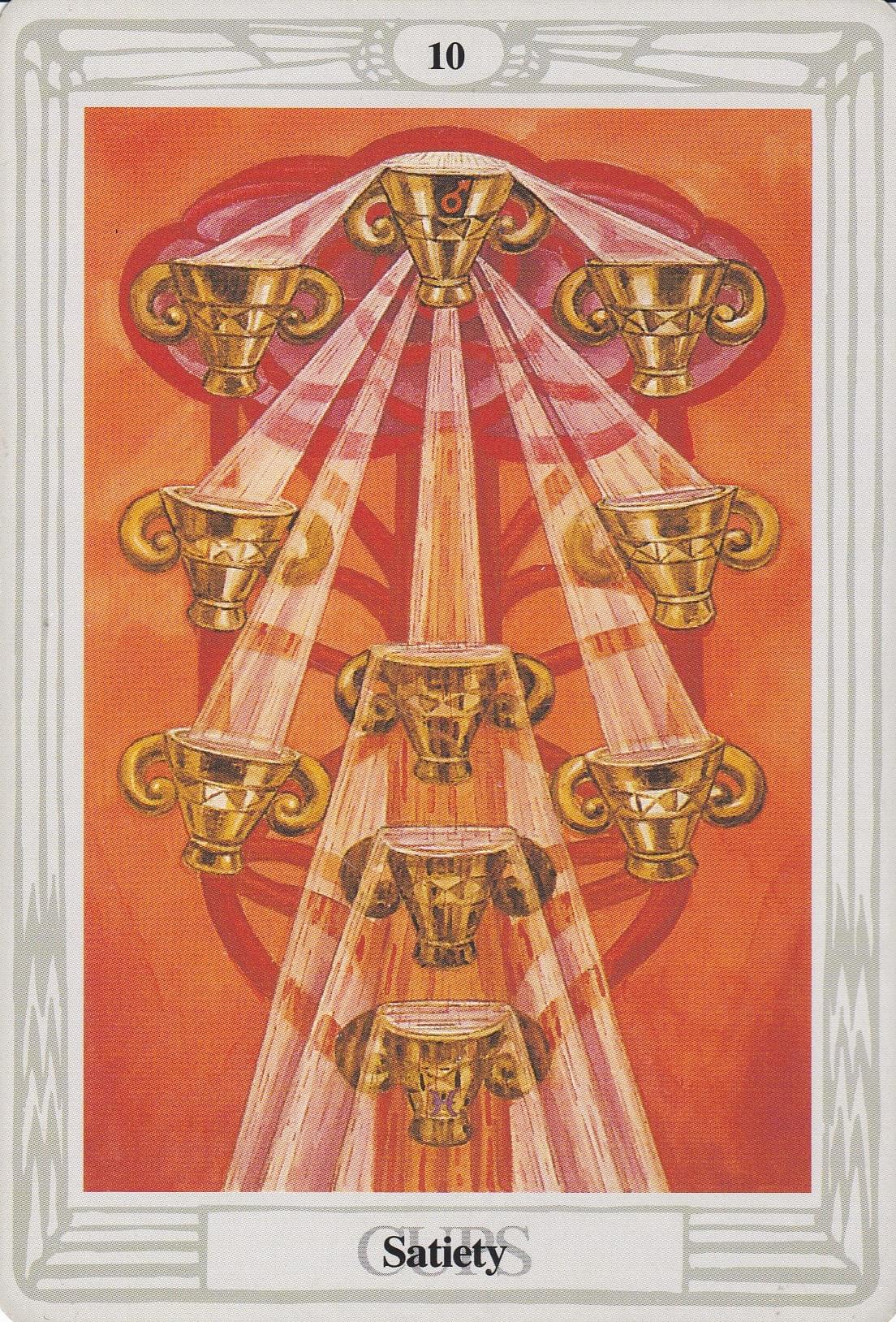
But in the Qabalistic framework, a deeper meaning unfolds. Mars (Aries), the God of War, hurls his fire into the Piscean waters of Briah—the Creative World. Instead of dispersing, the fiery impulse drives the waters forward in a rush of emotional intensity. This flood of creative power crashes into Malkuth, the material sphere, producing an overwhelming excess of feeling, abundance, and emotional saturation.
Thus, the Thoth 10 of Cups does not reflect the ordinary astrological weakness of Mars in Pisces. Rather, it depicts the paradoxical strength born when fiery Mars presses upon boundless Water, forcing its tides into completion, overflowing into the manifest Earth.
The Hermetic Lesson
In Hermetic symbolism, the 10s are thresholds. They mark both the completion of a cycle and the preparation for the Ace of a new suit. The 10 of Cups tells us that the joy of this fullness cannot be clung to. To hold it too long is to fall into illusion, but to recognize it as a turning point is to ride its wave into new creation.
The Hermetic axiom applies here: “Change is Stability.” The perfected success of this card is not a final rest but the joyous signal that one must now pour out the cups and begin again.

The Thoth 10 of Cups – The Conflict of Satiety (Mars in Pisces, Malkuth in Briah)
The imagery of this card expresses the Hermetic teaching that all true happiness is inspired from above, descending into us from the Macrocosmic Self. Happiness, then, is not merely pleasure but a harmonious state of consciousness—a melody where Spirit, Mind, and Body are tuned to one chord, resonating in perfected balance. This is why Crowley names it The Lord of Perfected Success.
Yet the Thoth card also whispers its caveat: all things must pass. The ten overflowing cups tilt precariously, suggesting that their contents cannot remain contained forever. Just as the second law of thermodynamics reminds us that order dissolves into disorder, so too must every perfected cycle eventually empty. Without change, there can be no challenge; and without challenge, there can be no further creativity.
Mars in Pisces – The Clash of Elements
Here lies the paradox: the astrological attribution of Mars in Pisces.
Mars is the gross, violent force of the warrior—the mythic God of War, who attacks every point of stability to drive movement forward.
Pisces, by contrast, is peaceful, spiritual, psychic, receptive, and boundless like the sea.
The combination is deeply uneasy. Mars resists Pisces’ gentleness; Pisces resents Mars’ aggression. Where Pisces seeks unity and stillness, Mars provokes disruption and conflict. Many astrologers have long considered Mars in Pisces one of the weakest or most problematic placements in the zodiac, as the fiery spear of Mars is blunted in the formless ocean.
Yet in the Thoth 10 of Cups, this very tension is the key. Mars forces the tranquil waters of Pisces into motion, stirring up their passivity into a flood. This flood surges into Briah, the Creative World, and descends into Malkuth, the Kingdom, manifesting as an overabundance of emotion and perfected fullness on the material plane.
The Esoteric Warning
The card therefore teaches a paradoxical truth:
Happiness is divine—a reflection of the Macrocosm within us.
But happiness cannot be frozen—when perfection is held too tightly, Mars breaks it apart to ensure movement continues.
Thus, the 10 of Cups is not only the vision of bliss, but also the warning that the proper work of Water has been completed. The current is shifting. The cycle of joy must now give way to new challenges, so that creation may continue to unfold.
In the Hermetic view, even the “worst” astrological positions are holy necessities in the cosmic dance. Mars in Pisces, for all its tension, guarantees that the perfected harmony of Satiety does not stagnate into delusion, but is emptied—making room for the next act of Creation.

Mars in the house of Pisces can have some unique characteristics in astrology. However, it's important to note that astrology is a belief system that shows some analytical power and should be interpreted subjectively. Here are some general traits associated with Mars in Pisces:
Passive Aggression: Mars is the planet of action, energy, and assertiveness, but Pisces is a water sign known for its passive and sensitive nature. When Mars is in Pisces, individuals may express their desires and frustrations in a more indirect or passive-aggressive manner.
Creative Energy: Pisces is a highly creative and imaginative sign, and when Mars combines with this energy, it can lead to a strong drive to channel one's energy into artistic or spiritual pursuits. These individuals may excel in creative endeavors such as music, art, or writing.
Compassion and Empathy: Pisces is also known for its empathetic and compassionate qualities. With Mars in Pisces, individuals may be more inclined to fight for humanitarian causes and use their energy to help others. They may have a strong desire to make the world a better place.
Lack of Direction: On the downside, Mars in Pisces can sometimes struggle with a lack of direction or clarity in their actions. Their energy may scatter, and they might find it challenging to assert themselves decisively in certain situations.
Sensitivity to Surroundings: Mars in Pisces individuals can be highly sensitive to their environment and the emotions of others. They may be easily influenced by the energies around them, which can either be a strength or a vulnerability, depending on the circumstances.
Escapism: Pisces is associated with the desire to escape reality, and Mars in Pisces individuals may sometimes use various forms of escapism, such as daydreaming, creative pursuits, or even substance abuse, as a way to cope with stress or conflict.
Intuitive Action: Despite their sometimes passive appearance, those with Mars in Pisces can be incredibly intuitive when it comes to taking action. They may trust their gut feelings and instincts when making decisions.
It's important to remember that astrology is a complex and nuanced field, and the influence of Mars in Pisces can vary depending on the individual's entire birth chart, including the positions of other planets and astrological factors. Personalized astrology consultations with a professional astrologer can provide a more detailed and accurate interpretation based on an individual's unique birth chart.


Crowley and his Supernal Triangle hat
The Thoth 10 of Cups – Satiety and the Sinister Surfeit
In his letter to Lady Frieda Harris, dated December 19, 1939, Crowley gave unusual emphasis to the sinister undertones of the 10 of Cups – Satiety. He wrote:
“The background; it ought to look menacing. There is something very sinister about this card. It suggests the morbid hunger which springs from surfeit. The craving of a drug addict is the idea. At the same time, of course, it is the final agony of descent into illusion which renders necessary the completion of the circle by awakening the Eld of the All-Father.”
This is a profound departure from the superficial view of “happiness fulfilled.” Crowley insists that the danger of this card lies in its very perfection—for once every cup is full, the soul, like an addict, can only crave more. This craving is not born from lack but from excess. Satiety becomes not only pleasure, but the menace of overindulgence, the sickness of too much.
Perfection and the Dream of the All-Father
Crowley’s warning resonates with the Hindu and Tibetan cosmologies:
In Hindu thought, Shiva as the All-Father (or Brahma as the Dreamer of the Worlds) sustains creation in his dream. Should he awaken, the dream dissolves, and the universe ceases to exist.
In Tibetan iconography, Yama, the Lord of Death, likewise devours the dream of manifestation, returning it to void so that the cycle may begin again.
In both systems, perfection belongs not to the material worlds but to the Invisible Infinite. The material, by its very nature, is measured, limited, and cyclic. But the Infinite—like water—remains unchanged regardless of what is poured into it. You can add countless forms, names, and appearances to the ocean of Mind, but its infinite nature remains unmeasured, inviolate, and invisible.
Thus, Satiety marks not only the fullness of happiness, but also the recognition that all perfected forms must collapse back into the Infinite, where the dream is rewritten. The completion of the circle Crowley refers to is this cycle of perfection, dissolution, and rebirth.
The Hermetic Lesson
The 10 of Cups is therefore not simply “happily ever after.” It is the ecstasy before dissolution, the sweetness of completion that simultaneously foreshadows its own undoing. The menacing background, the tilting cups, the over-saturation—all suggest that the bliss of perfection leads inexorably to the awakening of the All-Father, who sweeps the board clean for a new creation.
Hermetically, this card reminds us that Perfection cannot dwell in the manifest. It belongs to the Invisible One, the Macrocosmic Self, which remains untouched by cycles of order and disorder. Our joy in the 10 of Cups must therefore be tempered with wisdom: happiness is real, but it is transient; it must flow, empty, and be renewed.
As the Qabalistic doctrine teaches: “Change is stability.” Without dissolution, there is no new creation. Without the awakening of the Dreamer, there is no fresh dream.

Entropy, the Trimūrti, and the Supernal Triad
In order to understand the 10 of Cups – Satiety, we must address the hidden tension in all manifestation: entropy. The cups are full, the harmony is perfect, but the law of the universe demands that perfection dissolves into disorder. In modern physics, this is the Second Law of Thermodynamics, the inevitable increase of entropy.
From a Hermetic and Hindu perspective, this principle is not “evil” but divine necessity. In Hindu cosmology, this role belongs to Shiva, the Destroyer, who clears away forms that have reached completion. Just as entropy undoes the order of a closed system, Shiva ensures that no perfection in the material world becomes permanent stagnation.
But entropy alone would reduce the dream of creation into chaos. Therefore, Hindu thought introduces a balancing principle: Vishnu, the Preserver. From the “heart chakra” of Brahma—the Dreamer-Creator—emerges the sustaining force that maintains balance, order, and continuity amidst the cyclic play of creation and dissolution.
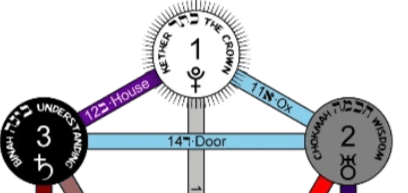
The Supernal Trinity on the Tree of Life
Hermetically, this parallels the Supernal Triad of the Qabalistic Tree:
Kether (The Crown – The Dreamer): The pure spark of creation, analogous to Brahma as the one who dreams the universe into being.
Chokmah (Wisdom – The Outpouring Force): The raw, dynamic, “destroying” energy that shatters stasis, akin to Shiva as Destroyer. Chokmah is the whirling fiery force that prevents perfection from petrifying into illusion.
Binah (Understanding – The Preserver’s Womb): The matrix that receives and stabilizes, reflecting Vishnu as the preserver of form, holding order amidst constant flux.
Thus, entropy (Shiva/Chokmah) is not an aberration but a necessary completion of the trinity of creation. Brahma/Kether dreams the forms, Shiva/Chokmah clears the ground, and Vishnu/Binah maintains the rhythm and continuity of existence.
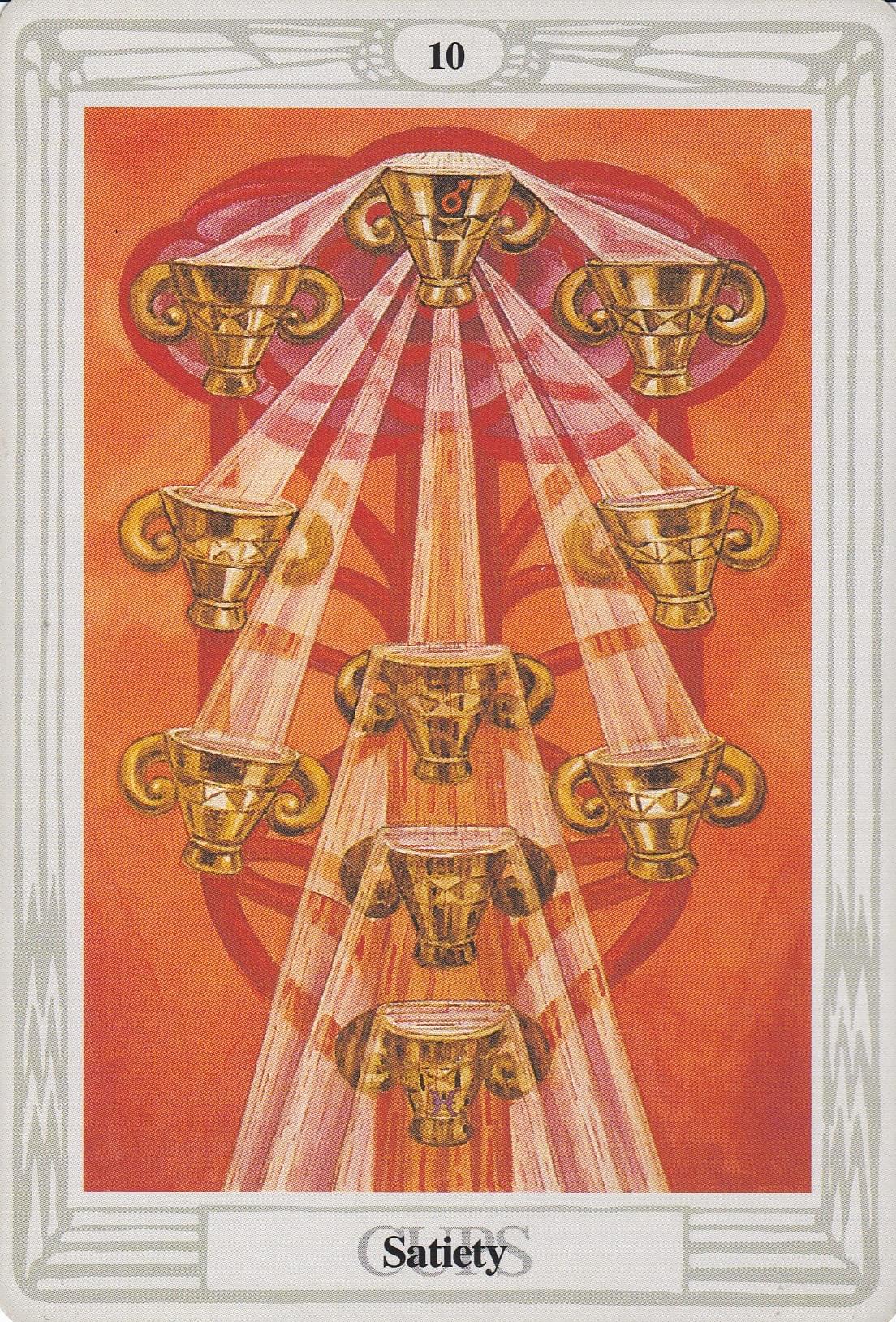
The Lesson in Satiety
In the 10 of Cups, the fullness of happiness reflects Brahma/Kether’s perfected dream, descending into Malkuth. But here, entropy/Shiva intrudes—Mars in Pisces agitates the waters, overturning perfection to force renewal. Vishnu/Binah ensures this renewal does not collapse into pure chaos but flows into a new cycle, a new dream, another rising of the cups.
Perfection in the manifest world is always temporary, because the Infinite is ever-revealing itself through cycles. This is why Crowley described Satiety as both perfected success and morbid hunger. Without Shiva’s destruction and Vishnu’s preservation, Brahma’s dream would collapse into either lifeless permanence or meaningless chaos. The cycle itself—creation, preservation, destruction—is the only true stability.

In older Hindu mythology, Brahma is generally regarded as the Creator god, while Shiva is the Destroyer, and Vishnu is the Preserver. The dynamics between these gods form the Hindu trinity known as the Trimurti—each with distinct roles in the cosmic cycle of creation, preservation, and destruction.
Brahma as the Creator and the Concept of the Dream (Universal Collective Unconscious)
Brahma is often described as emerging from the primordial waters, seated on a lotus that grows from the navel of Vishnu. In this context, Brahma is associated with creation, and in some interpretations, he is regarded as a dreaming god. The "dream" could symbolize the unfolding of the universe, which is created through the divine imagination of Brahma. In Hindu cosmology, creation is cyclic and temporary, much like a dream, and Brahma’s act of creation is seen as being part of this cyclical process of birth, life, and dissolution.

Brahma himself is not frequently worshiped today, as he is believed to have completed his role as Creator. He initiated the process of creation, and from there, the universe continues to operate under the balance maintained by Vishnu and Shiva.
Vishnu’s Birth and Connection to the Heart Chakra
There is a rich symbolic relationship between Brahma and Vishnu, particularly in the way Vishnu is said to be born from Brahma’s heart chakra. The heart chakra, or Anahata, is considered a central energy point in the body, symbolizing compassion, love, and balance—qualities attributed to Vishnu’s role as the Preserver of the universe. Vishnu’s birth from Brahma’s heart is symbolic of the way the universe requires not just creation but also sustenance, with Vishnu embodying the qualities necessary to preserve balance and order.
In some stories, Vishnu is seen as emanating from Brahma's navel. This imagery—Brahma creating the universe but Vishnu nurturing and sustaining it—illustrates the inseparable roles of creation and preservation. The divine hierarchy and interplay between Brahma and Vishnu symbolize the different yet complementary forces necessary for the universe's existence.
Shiva’s Role as Creator and Destroyer (Mars/Aries)
Although Shiva is primarily known as the Destroyer, he also holds a creative aspect in Hindu mythology. In the larger cosmic cycle, destruction is essential for rebirth and regeneration. This makes Shiva both a creator and destroyer, as destruction paves the way for new creation. In some interpretations of Hindu cosmology, Shiva is seen as dreaming, where the universe comes into being and dissolves in his mind, paralleling the idea of Brahma’s creation through dreaming.
Conclusion
In summary:
- Brahma is the primary Creator god, associated with the act of creation, and in some myths, he is considered a "dreaming" god.
- Vishnu, the Preserver, is connected to the heart chakra and is born from Brahma’s navel or heart, representing the essential energy of preservation.
- Shiva plays the dual role of Creator and Destroyer, indicating the cyclical nature of existence and the Solar Self/Soul.
This mythology highlights the complementary roles of creation, preservation, and destruction, which are vital to the Hindu understanding of cosmic balance.

Yet, through all this saturation of happiness, when the Thoth 10 of Cups card is thrown during a reading, it means that emotional matters arranged and settled; there will be no further creation in this phase. Just remember that pleasure proceeds to dissipation and fanatical hunger, as energy-in-motion follows the second law of thermodynamics. The message here is," Enjoy the moment of completion, all is done. Sit back, sip a warm drink, but avoid stagnation, for once again, you'll be called on to perform at your best."
To be sure, when Tarot is used for public Divination, it is best applied to mundane matters, whereas the meaning may be different if applied to a more spiritual plane of Hermetic Qabalah initiate and/or aspirant. The Placement of the cards and reader intuition in the reading will clarify this statement. Either way, a cycle of Happiness is complete; it is saturated. This cycle has ended as all 10's cycle to 01.

Up the Down spiral Staircase
10 is a number that when added together [1+0 =1), you end up at the beginning. It is the "up the down staircase" number that places us on top of one flight of stairs, only to find out that we are at the bottom of another flight. There are some Tarot readers that forgot this part of the Arcana, and call the Ten of Cups, permanent success, but Qabalists know that the only permanency in this manifested world of the One Energy Universe is change/transformation, so to have permanent success in manifestation, one must be entirely happy with constant change and the surprises it brings.
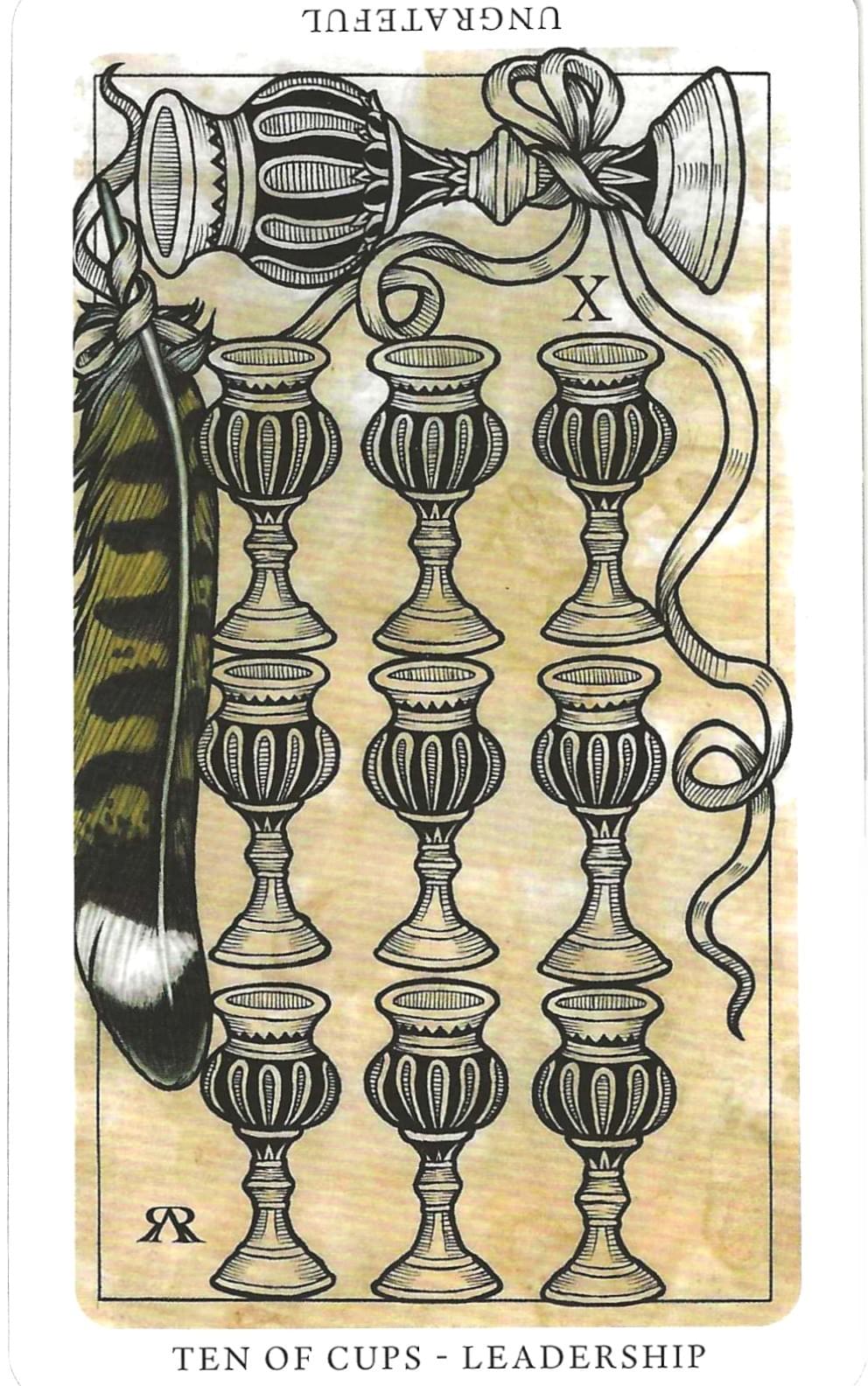
Medieval Feathers Tarot – 10 of Cups
In the Medieval Feathers Tarot, the 10 of Cups is depicted as a tight clustering of goblets—so crowded together that there is no more room for expansion. At the crown of the image, a single large goblet presides over the other nine, compelling their obedience and demanding unity. Beneath them lies the lesser night hawk’s feather, serving as a stabilizing support, encouraging cohesion and collective effort.
This imagery emphasizes the themes of leadership, responsibility, and harmony within community. When happiness or success reaches its culmination, it does not mean passivity. Rather, the card advises the querent to step into the role of exemplar—to guide others through honesty, integrity, and courtesy. True happiness here is not a private indulgence but a shared state of harmony that requires stewardship. The teaching is clear:
Take responsibility for your actions.
Do not expect others to do your work, for your mission is yours alone.
Likewise, do not overreach into another’s destiny, for each person carries their own cup.
In this sense, the Medieval Feathers 10 of Cups reflects a communal fullness—a happiness achieved only through mutual support, respect, and individual accountability.
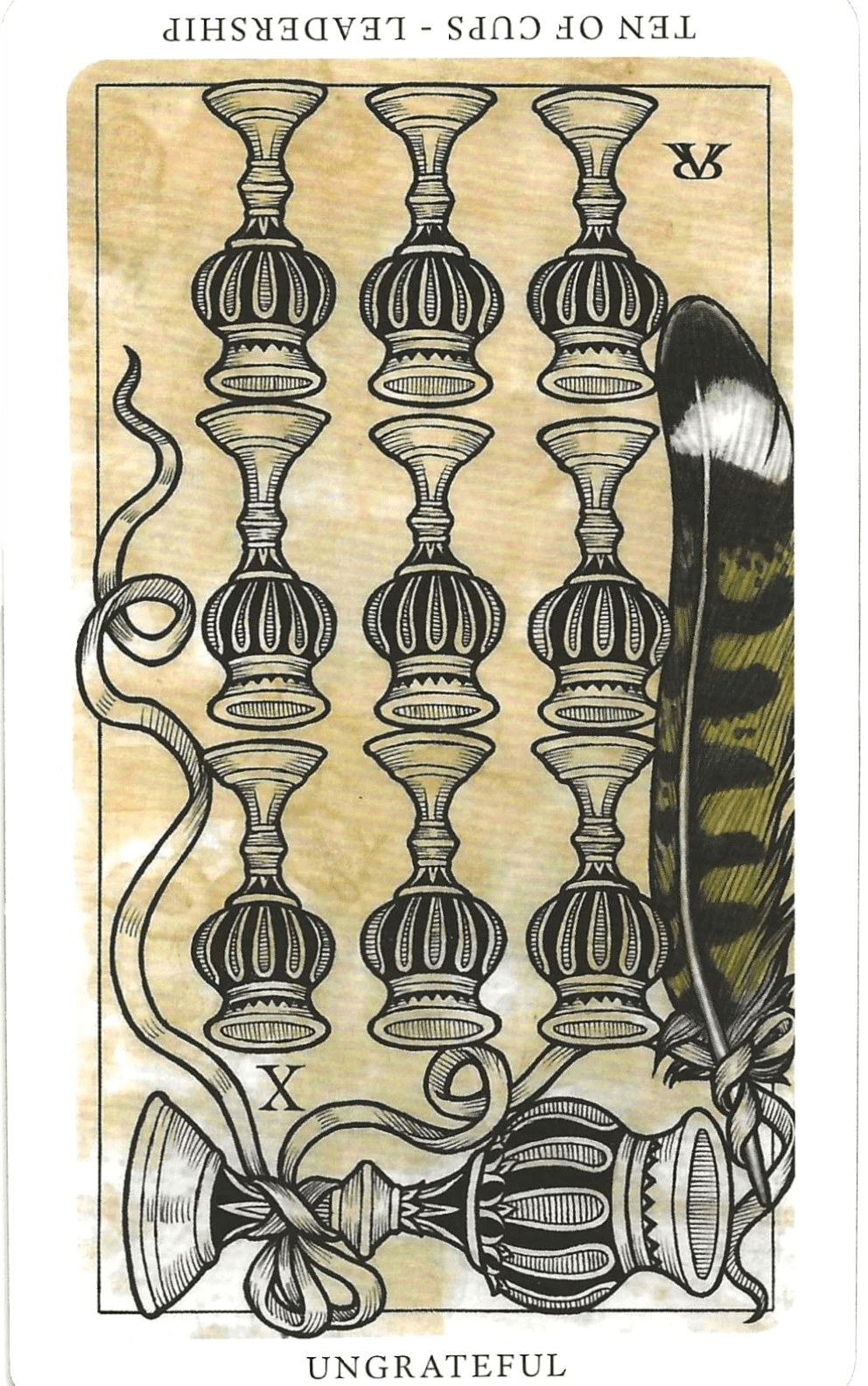
Reversed / Inverted Meaning
When reversed, the card warns of ingratitude. You may have forgotten to acknowledge those who have supported you, assuming their contributions as given rather than gifted. This lack of recognition sours the atmosphere, leaving others with the impression that you are ungrateful, even if that was never your intention.
As a result, harmony dissolves, and the flow of goodwill turns stagnant. In practical terms, this inversion suggests that progress will stall until gratitude is expressed and relationships are repaired. The lesson here is that gratitude fuels continuation, while ingratitude halts the cycle of blessing.
Hermetic Reflection
Compared to the Thoth Tarot’s Satiety—which warns of the sinister dangers of perfection tipping into excess—the Medieval Feathers deck offers a gentler counsel: do not take the fullness of community for granted. Both systems agree that the 10 of Cups is the climax of a cycle, but where the Thoth emphasizes the dissolution that follows, the Medieval Feathers emphasizes the moral responsibility of the leader who holds the overflowing goblet.
Happiness, whether individual or communal, must be honored through gratitude and responsibility if it is to remain meaningful. Otherwise, the abundance of ten cups becomes merely a crowded burden, collapsing under its own weight.

The Lord of Material Happiness – Malkuth and the Limits of Satiety
Yet here dances the so-called “Lord of Material Happiness,” for the 10th Sephirah, Malkuth, is the Kingdom where all higher forces crystallize into material experience. In the 10 of Cups – Satiety, everything seems perfectly well. The cups overflow, harmony appears secure, and the dream of happiness seems to have found its form in the manifest world.
But this, too, has a boundary. One can go no further in Malkuth. The Kingdom is not a gate upward but the terminus of descent. This should not surprise us, for happiness rooted in material things has never proven permanent. As the sages of India would say, this is a “Neti, Neti” world—“not this, not that.” The material can never deliver the infinite satisfaction the soul longs for, because matter is a realm of passing forms, not eternal essence.
The Illusion of Security
In modern language, we might say that Malkuth is where the “military-industrial complex” of existence builds its structures, believing security can be engineered out of transient forms. But the Hermetic truth is that all forms must dissolve. The material world promises happiness, but never without the hidden clause of impermanence.
The 10 of Cups is thus both a gift and a warning:
It is the joy of creation fulfilled in the Kingdom, the momentary bliss of form perfected.
It is also the veil of illusion, for in a world of entropy and cyclic dissolution, the cups must eventually empty.
The Hermetic Lesson
The Satiety of Malkuth teaches us to enjoy fullness without clinging to it. This is why Crowley insisted that there is something “sinister” about the card—it lulls us into the belief that material happiness is enough, when in fact the spiritual impulse must always seek beyond.
The true Lord of Happiness is not found in the material cup, but in the invisible source that endlessly fills and empties it. The 10 of Cups is the completion of the dream at the lowest level; but for the Magus, it is also the signal that it is time to turn back upward, to trace the cycle anew.

Material consumption hypnotic madness
The Shared Lesson of the 10 of Cups
Both the Thoth 10 of Cups (Satiety) and the Medieval Feathers 10 of Cups carry a warning against the illusion that happiness is found in things. The continual search for the “latest and greatest” object of desire inevitably devolves into its own form of madness. Material consumption, mistaken for joy, quickly reveals itself to be addiction rather than fulfillment.
The Tarot reminds us that when one commits to walking their true path, some degree of suffering is always encountered. The pursuit of wholeness brings challenges that strip away false securities. Through this tempering, we discover that “happiness” is not the ultimate goal of spiritual life. The true goal is Inner Fulfillment—a state that may not always be pleasurable, but which grants a steadfast presence rooted in the Soul.
This inner fulfillment arises not from external acquisitions but from the realization of one’s intimacy with Being itself. When you know your own presence is enough, you become a vessel of transformation; your mere existence radiates significance and power, for you stand as the image of Divinity within the microcosm.
Thus, in Malkuth, the 10th Sephirah, the Goal of the Divine is met: the Dreamer beholds Itself in form. The human soul, as tzelem Elohim (the Image of God), manifests the completed Will in matter. This is the deeper happiness—not the fleeting joy of “having,” but the enduring bliss of being

Adam Khadmon- the Heavenly Human

Adam Kadmon is a Human Archetype-Hence all Genders. The intuitive word of the Divine can be spoken by humankind through Daath.

The Tens imply, fixed, culminated, completed Force and the Lost Soul Tarot is like the Rider-Waite-Smith card with the 10 cups held in the sky but without a rainbow of colors but still concentrates its imagery on the phenomena that all happiness comes from the above. This concept is opposed to the mundane belief that "Accumulation of Things" makes one happy. The idea here is that Happiness created us as it's material expression, rather than the gathering of material makes us happy. When observing a child playing, one may understand that happiness is what we are and not what we seek. Spirit is very happy to manifest; However, indoctrination and dogma have clouded our joy. MALKUTH, Earth, is the 10th Sephiroth on the Tree of Life, and is the placement of the 4 Tens.
Comparing the meanings of the Tarot number 10 in numerology and gematria reveals both similarities and distinctions that reflect the unique perspectives of each system. Here’s a side-by-side comparison of the key characteristics:
1. Symbolism of Completion and Perfection
- Numerology: In numerology, the number 10 is often seen as a number of completion and wholeness, representing a full cycle or the end of a phase. It combines the independence and initiation of the number 1 with the unlimited potential and connection of the number 0, signifying a point of transition or transformation into a new beginning.
- Gematria: In gematria, the number 10 similarly represents completion and perfection, especially divine order and structure. It symbolizes the totality of creation and manifestation, as seen in its connection with the Ten Sephiroth on the Tree of Life.
2. Potential and New Beginnings
- Numerology: The 10 carries the energy of both the number 1 (new beginnings, leadership) and the 0 (the infinite, the void, spiritual potential). It indicates the ability to bring ideas into reality, using the force of will and divine connection to manifest outcomes. There’s a sense of rebirth, moving from the old to the new.
- Gematria: In gematria, the number 10, through the letter Yod (י), symbolizes the point of origin from which creation begins. It is the divine spark, representing potential and the seed of all things. Yod is seen as the smallest, simplest form, yet holds the potential for vast growth and creation.
3. Connection to Divinity
- Numerology: The number 10 can be seen as a number that connects the earthly and the divine, blending the material world (1) with spiritual infinity (0). This speaks to the idea of harmonizing spiritual and physical realms to achieve enlightenment or fulfillment.
- Gematria: In gematria, the number 10 is closely tied to divine concepts, particularly through the Tetragrammaton (YHVH), where Yod (10) represents the first letter of God's sacred name. It also reflects divine order through the Ten Commandments and the Ten Sephiroth, placing the number in direct relation to God’s interaction with creation.
4. Structure and Foundation
- Numerology: In numerology, 10 suggests laying strong foundations for future growth. It can signify a point of self-mastery or achieving personal goals, with the number 0 amplifying the energies of the 1. This reflects both independence and connection to a higher purpose.
- Gematria: In gematria, the number 10 is foundational in its relationship to the Tree of Life, where the Ten Sephiroth form the framework of creation and reality. Each Sefirah represents an aspect of existence or divine will, and together, they form a complete structure.
5. Dual Nature of Power
- Numerology: The number 10 in numerology can reflect both personal power (1) and universal potential (0). It holds the duality of independence and divine guidance, suggesting mastery over both material and spiritual realms.
- Gematria: In gematria, Yod (10) is both the smallest and most fundamental letter, showing that even the smallest amount of divine energy or intervention can have a profound impact. It reflects the idea that great power often emerges from humble beginnings.
6. Cycles and Rebirth
- Numerology: The number 10 marks the completion of one cycle and the beginning of another, symbolizing continuous growth and evolution. It often indicates reaching a peak and preparing for a new start.
- Gematria: While gematria doesn’t emphasize cycles in the same way, the concept of creation and manifestation is central. The number 10 represents both the spark of creation and its complete manifestation, which can be seen as a cyclical process in the unfolding of the universe.
Summary of Comparison:
| Aspect | Numerology (10) | Gematria (10) |
|---|---|---|
| Completion & Perfection | End of a cycle, transition to a new phase | Divine order, creation, and manifestation |
| Potential & New Beginnings | Rebirth, power to manifest goals | Yod (point of creation), divine potential |
| Connection to Divinity | Harmony of physical and spiritual realms | Divine name (YHVH), Ten Sephiroth, Ten Commandments |
| Structure & Foundation | Personal mastery, strong foundations | Tree of Life, framework of existence |
| Duality of Power | Independence (1) + Infinite Potential (0) | Yod: smallest but holds immense divine power |
| Cycles & Rebirth | Ending one phase, beginning another | Unfolding of divine creation, potential manifesting |
Both numerology and gematria see the number 10 as a powerful symbol of completion, potential, and divine connection, but numerology emphasizes personal transformation and the interaction between the material and spiritual, while gematria focuses on divine order, creation, and the role of the divine in shaping reality.

When thrown in a divination, the Ten of Cups card implies:
- Matters arranged as wished, permanent and lasting success of a physical issue, as it is done and finished.
- However, being a 10, this is a short duration card, as 10's are a union of 1 and 0, so from one to zero is the flow of this cards influence.
- Often one is only satiated and/or overly full for a brief period, much like the impermanence of a drug, with struggle around the corner.
- The 10 of Cups, although in the stable form of the Tree of Life, has a conflicting element that causes a tilting of the Cups, spilling water from the Great Lotus that overhangs the complete system, implying some effort is required.
- This meaning of material success is reinforced if the 10 of Cup's lands on the position of "Beneath you" or "of House and Home", on a Celtic cross layout. In fact, which would be paramount for this card, as it is a 10 of Malkuth (Kingdom) in an Earthly existence position. However, the tilting of the cups shows us that 10s are the end of one issue, and the beginning of the unfathomable "new".
- Emotional fulfillment in intellectual ideas.
- Search for the path of inner completion.
- Optimism.
- Fulfillment.
- Dreams that come true on an emotional level.
If ill defined by the surrounding cards, it implies:
- Bathos.
- Inner emptiness.
- Sentimentality.
- Quarrelsome relationship.
- Disharmony
Thank you for your interest, comments, and support. Your generosity blesses you. May you live long and prosper.
Thoth Master Class: Western Hermetic Qabalah & Tarot
One-on-One Esoteric Training with Magus Eli
Awaken Your Resonance with the Thoth Tarot
This is not an ordinary Tarot class. The Thoth Master Class is a personalized journey into Hermetic Qabalah and the mysteries of the Thoth Tarot, guided one-on-one by Magus Eli.
These sessions are designed to align your soul’s archetypes with the Tree of Life, blending mystical philosophy with hands-on Tarot practice for profound spiritual transformation.
What Makes This Class Unique?
Private Instruction: Just you and the Magus in a 2-hour Google Meet session — fully tailored to your goals.
Flexible Scheduling: Weekly, every two weeks, or monthly (12 sessions recommended for full mastery).
Recorded Lessons: Every session is recorded for your personal review and ongoing study.
Hermetic Depth: Learn Tarot as a gateway to the Tree of Life, elemental forces, and pathworking.
Practical Mastery: Practice Tarot layouts live with guided interpretation to build confidence and resonance.
What You’ll Learn
The structure of the Thoth Tarot: Major Arcana, Minor Arcana, and Court Cards
The Western Hermetic Qabalah: Ten Sephiroth, Four Worlds, and 22 Paths
Pathworking and meditative techniques using Tarot as a key to inner temples
Hermetic spreads and ritual applications for personal transformation
Developing personal gnosis and building your own mystical framework
Required Materials
The Qabalistic Tarot: A Textbook of Mystical Philosophy by Robert Wang
Thoth Tarot deck (Crowley/Harris edition preferred)
Personal journal or Book of Shadows
Is This Class for You?
No prior Tarot experience is required — beginners and advanced seekers are welcome.
Perfect for anyone drawn to Hermetic wisdom, deep archetypal work, and personal gnosis.
How to Enroll
Email eli@elitarotstrickingly.com to request availability and begin your personalized resonance mapping session.
Call to Action
Awaken the archetypes within. Enter the living mysteries of the Thoth Tarot. Begin your Master Class today.
3 Western Hermetic Tarot and Magick websites helping people become more magic and less tragic since 2010.
For information regarding a personal online Thoth Tarot Reading and/or Thoth Master Tarot Classes, log onto-www.elitarotstrickingly.com- and click on the Tarot-Store page. Thank you.
New Traditional Tarot Blog and tarot store.
For Western Hermetic Designed Ritual Invocations and Magick blog.
